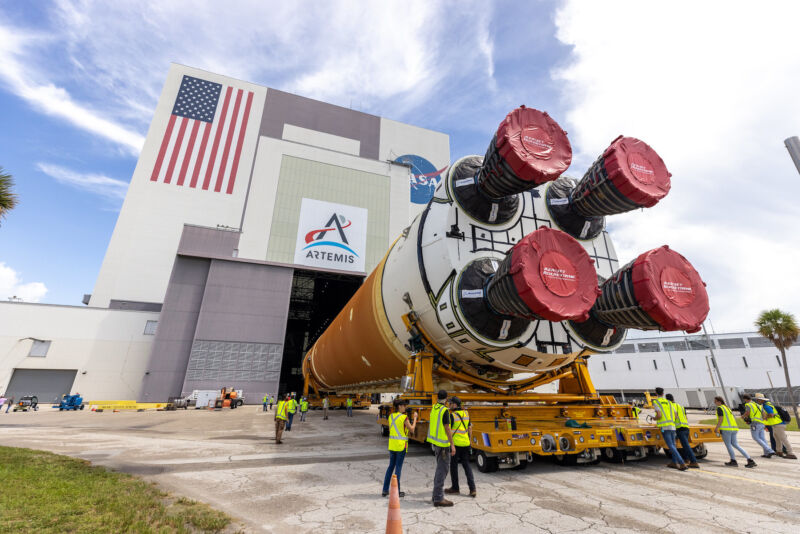

The central piece of NASA’s second Space Launch System rocket arrived at Kennedy Space Center in Florida this week. Agency officials intend to start stacking the towering launcher in the next couple of months for a mission late next year carrying a team of four astronauts around the Moon.
The Artemis II mission, officially scheduled for September 2025, will be the first voyage by humans to the vicinity of the Moon since the last Apollo lunar landing mission in 1972. NASA astronauts Reid Wiseman, Victor Glover, Christina Koch, and Canadian mission specialist Jeremy Hansen will ride the SLS rocket away from Earth, then fly around the far side of the Moon and return home inside NASA’s Orion spacecraft.
“The core is the backbone of SLS, and it’s the backbone of the Artemis mission,” said Matthew Ramsey, NASA’s mission manager for Artemis II. “We’ve been waiting for the core to get here because all the integrated tests and checkouts that we do have to have the core stage. It has the flight avionics that drive the whole system. The boosters are also important, but the core is really the backbone for Artemis. So it’s a big day.”
The core stage rolled off of NASA’s Pegasus barge at Kennedy early Wednesday, following a weeklong ocean voyage from New Orleans, where Boeing builds the rocket under contract to NASA.
Ramsey told Ars that ground teams hope to begin stacking the rocket’s two powerful solid rocket boosters on NASA’s mobile launcher platform in September. Each booster, supplied by Northrop Grumman, is made of five segments with pre-packed solid propellant and a nose cone. All the pieces for the SLS boosters are at Kennedy and ready for stacking, Ramsey said.
The SLS upper stage, built by United Launch Alliance, is also at the Florida launch site. Now, the core stage is at Kennedy. In August or September, NASA plans to deliver the two remaining elements of the SLS rocket to Florida. These are the adapter structures that will connect the core stage to the upper stage, and the upper stage to the Orion spacecraft.
A heavy-duty crane inside the cavernous Vehicle Assembly Building (VAB) will hoist each segment of the SLS boosters into place on the launch platform. Once the boosters are fully stacked, ground teams will lift the 212-foot (65-meter) core stage vertical in the transfer aisle running through the center of the VAB. A crane will then lower the core stage between the boosters. That could happen as soon as December, according to Ramsey.
Then comes the launch vehicle stage adapter, the upper stage, the Orion stage adapter, and finally, the Orion spacecraft itself.
Moving toward operations
NASA’s inspector general reported in 2022 that NASA’s first four Artemis missions will each cost $4.1 billion. Subsequent documents, including a Government Accountability Office report last year, suggest the expendable SLS core stage is responsible for at least a quarter of the cost for each Artemis flight.
The core stage for Artemis II is powered by four hydrogen-fueled RS-25 engines produced by Aerojet Rocketdyne. Two of the reusable engines for Artemis II have flown on the space shuttle, and the other two RS-25s were built in the shuttle era but never flew. Each SLS launch will put the core stage and its engines in the Atlantic Ocean.
Steve Wofford, who manages the stages office for the SLS program at NASA’s Marshall Space Flight Center, told Ars there are “no major configuration differences” between the core stages for Artemis I and Artemis II. The only minor differences involve instrumentation that NASA wanted on Artemis I to measure pressures, accelerations, vibrations, temperatures, and other parameters on the first flight of the Space Launch System.
“We are still working off some flight observations that we made on Artemis I, but no showstoppers,” Wofford said. “On the first article, the test flight, Artemis I, we really loaded it up. That’s a golden opportunity to learn as much as you can about the vehicle and the flight regime, and anchor all your models … As you progress, you need less and less of that. So Core Stage 2 will have less development flight instrumentation than Core Stage 1, and then Core Stage 3 will have less still.”